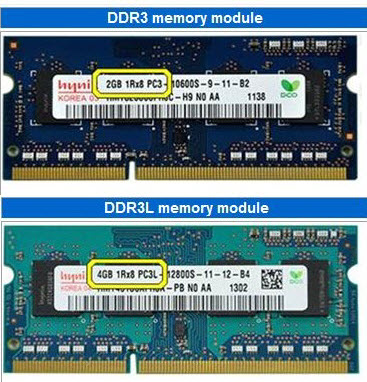DDR3L vs DDR3 Memory (RAM) Comparison
DDR3 and DDR3L are high performance RAM used with latest motherboards and processors. DDR3 memory can be classified into two types:
1. Normal DDR3 Memory
2. DDR3L Memory
Normal DDR3 or DDR3 RAM is a high speed single voltage computer memory that runs on 1.5V (volt). It is the successor of DDR2 memory and the primary benefits of DDR3 memory over DDR2 one is faster speed / frequency & bandwidth, needs lower voltage and generates lesser heat. Generally the speed of a DDR3 Memory ranges from 1066MHz to 2133MHz. Some even faster DDR3 memories exist but they are very expensive and are not that much popular. DDR3 RAM is not compatible with systems that specifically require 1.35V memory for their working.
What is DDR3L Memory?
DDR3L or DDR3-Low Voltage RAM is a high speed computer memory that has same pins and size that of a normal DDR3 RAM but it is dual voltage memory. DDR3L memory can run on both 1.5V and 1.35V, which means it can run on both low and high voltages. DDR3L memory is also backward compatible with DDR3 which means you can run DDR3L memory on a system or motherboard that uses or requires traditional or normal DDR3 RAM. In DDR3 SoDIMM “PC3L” is written on the JEDEC compliant text (Sticker on the RAM module) for identification purpose and in normal DDR3 memory the text written is “PC3” only. DDR3L is generally used with Intel 4th and 5th generation processors and AMD FX series CPUs. The main advantages of DDR3L memory over DDR3 is lesser power requirement, lesser heat generation, support for new processors & motherboards and somewhat increased performance.
There is also a less common DDR3LU (DDR3 Ultra Low Voltage) RAM that operates at 1.25V which is even less than DDR3L RAM.

Comparison of DDR3 and DDR3L Memory
DDR3 Memory |
DDR3L Memory |
|
| Voltage | 1.5V (Single Voltage) | 1.35V and 1.5V (Dual Voltage) |
| Pins | 240, 204 | 240, 204 |
| Backward Compatible | No | Yes, backward compatible with DDR3 |
| Size | DDR3 DIMM / SoDIMM | Same as DDR3 DIMM / SoDIMM Memory Module |
| Usage | Up to Intel 3rd Generation (Ivy Bridge) or older Processors | Intel 4th Generation (Haswell), 5th Generation (Broadwell), Skylake Processors, AMD FX series and higher processors |
| Advantages | Better and Faster than DDR2 RAM | Generates less heat and consumes less power than normal DDR3 RAM. Also performs a bit better than DDR3 RAM |
| Identification | PC3 written on JEDEC compliant text (Sticker on RAM module) | PC3L written on JEDEC compliant text |
Read more on RAM:

Hello sir,
u have explained very well but my small query is that can we use ddr3l ram in intel i3 3rd generation laptop because many website claim that we can use dr3l ram in intel i3 3rd generation system…kindly please clear my doubt.
Thanking you,
Raju Roy
Raju,
There is a very small, minut, benefit between DDR3 and DDR3L which lies in power consumption. DDR3 draws 1.5v. while DDR3L uses .15 of one volt less, equating to 1.35 volts.
As additional memory modules are deployed, the .15 of one volt may increase the significance of this factor, and contribute to raising the temperature on the motherboard as well.
All considered, I believe barring special purposes application to achieve some other random objective, using the newer low-voltage memory has merit. With the energy conservation climate we’re transitioning to motherboard Mfr. may very well, increase the production/availability of systems mandating DDRxxL by limiting the powerline to providing only 1.35 volts rather than 1.5v the histortic standard.